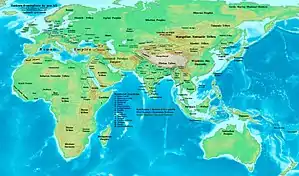Abiria
Abiria was the country of the Abhiras. It is mentioned in the Periplus of the Erythraean Sea and by Ptolemy in his Geographia.[1] The Periplus mentions it as Aberia with the coastal district Syrastrene (modern-day Saurashtra, Gujarat), and Ptolemy locates it above the Indus delta.[2]
Domains of the Abhiras Abhira country | |
|---|---|
 The country of the Abhiras is shown along with the Western Satraps | |
| Religion | Vedic Hinduism Buddhism |
| Government | Monarchy |
| Raja | |
| Historical era | Ancient history |
| Today part of | India |
Location
The Periplus of the Erythraean Sea and Geographia by Ptolemy locate Abiria between the lower Sindh valley and Kathiawar, apparently in southwest Rajputana and adjoining regions. In the Puranas however, the domains of the Abhira kings were located in the northwestern region of the Deccan.[3][4][5]
Mention by Ptolemy
Abiria was mentioned by Ptolemy when he described the territory of the ksatrapa Chastana:
Moreover the region which is next to the western part of India, is called Indoscythia. A part of this region around the (Indus) river mouth is Patalena, above which is Abiria. That which is about the mouth of the Indus and the Canthicolpus bay is called Syrastrena. (...) In the island formed by this river are the cities Pantala, Barbaria. (...) The Larica region of Indoscythia is located eastward from the swamp near the sea, in which on the west of the Namadus river is the interior city of Barygaza emporium. On the east side of the river (...) Ozena-Regia Tiastani (...) Minagara".
— Ptolemy Geographia, Book Seven, Chapter I
Mention in the Periplus of the Erythraean Sea
Abiria is also mentioned in the 1st century CE Periplus of the Erythraean Sea:
"Beyond the gulf of Baraca is that of Barygaza and the coast of the country of Ariaca, which is the beginning of the Kingdom of Nambanus and of all India. That part of it lying inland and adjoining Scythia is called Abiria, but the coast is called Syrastrene. It is a fertile country, yielding wheat and rice and sesame oil and clarified butter, cotton and the Indian cloths made therefrom, of the coarser sorts. Very many cattle are pastured there, and the men are of great stature and black in color. The metropolis of this country is Minnagara, from which much cotton cloth is brought down to Barygaza." Periplus, Chap. 41.[6][7]
References
- Alain Danielou, A Brief History of India (Inner Traditions, 2003), mentioned here
- Wadia, Sophia (1967). The Aryan Path. Theosophy Company (India), Limited.
- The Age of Imperial Unity. Bharatiya Vidya Bhavan. 1968.
- Sudhakar Chattopadhyaya (1974). Some Early Dynasties of South India. Motilal Banarsidass. pp. 128–130. ISBN 978-81-208-2941-1.
- "5 Post Maurya Dynasties (In South India)". History discussion. Retrieved 13 January 2021.
- Schoff, Wilfred H. (1912-01-01). The Periplus of the Erythræan sea: travel and trade in the Indian Ocean. Dalcassian Publishing Company.
- Source